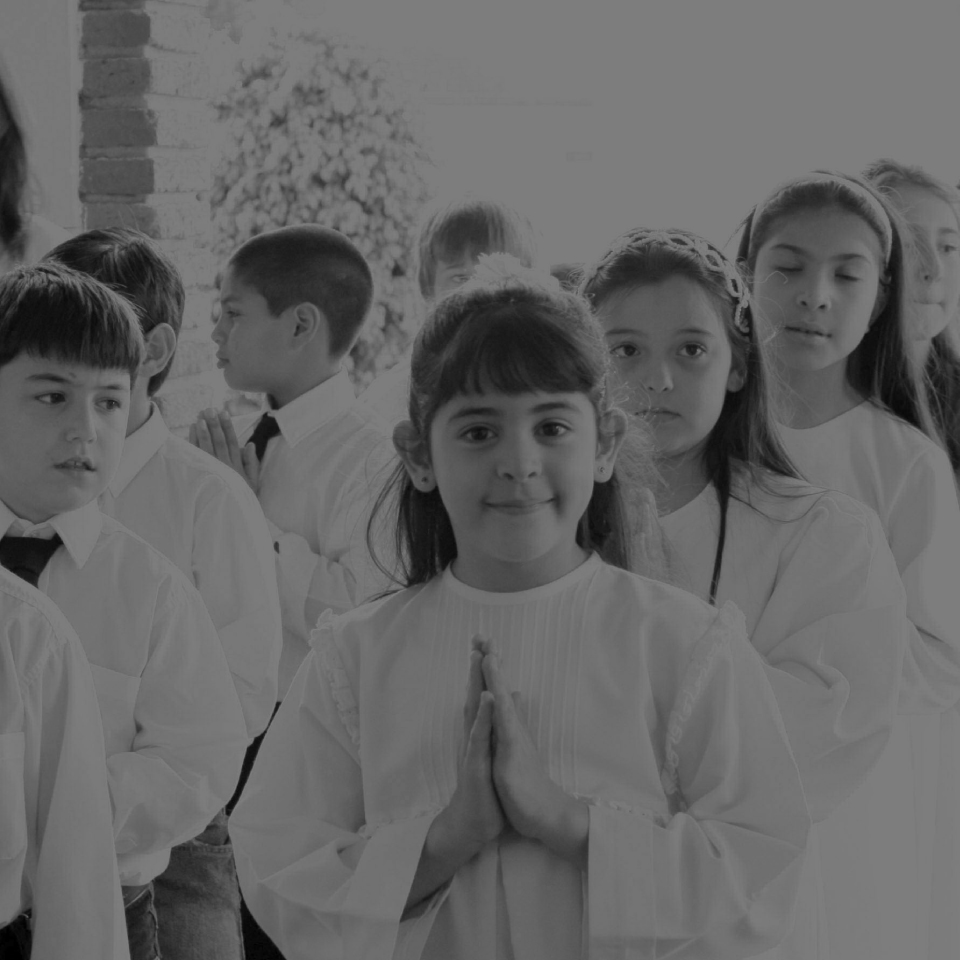In they came.
Little girls in pristine white dresses. Hair exquisite with flowing veils. White shoes spotless. Little boys in sports coats, ties, and dress pants. Hair trimmed to perfection. Faces shining from one last scrub. Two by two, they ambled down the central aisle with eyes glowing, palms pressed gently together and a final bow at the altar as they peeled off to sit with their beaming moms and dads, grandpas and grandmas, sisters and brothers. The feel in the sanctuary was holy, but electric. These were our children. This is our Church’s future.
This is First Holy Communion.
But what does it mean?
The Catholic Catechism describes the Eucharist as a “sacrament of love, a sign of unity, a bond of charity, a Paschal banquet ‘in which Christ is consumed, the mind is filled with grace, and a pledge of future glory is given to us.’”
It is bread and wine transformed into Body and Blood. It is the greatest of intimacies and the most profound of mysteries. It exceeds the notion of a “Thin Place” where the distance between God and man is diminished and grows ever closer. Instead, it is a moment of deep union between the broken and the Healer. It is “the source and summit of the Christian life.” And further, “The other sacraments, and indeed all ecclesiastical ministries and works of the apostolate, are bound up with the Eucharist and are oriented toward it. For in the blessed Eucharist is contained the whole spiritual good of the Church, namely Christ himself, our Pasch.”
Before I was welcomed into the Catholic Church in 2010, I did not receive the Eucharist for nine months. Prior to that, I had taken it without fully recognizing the propriety in abstaining until I had gone to Confession and had better appreciation of the Eucharist’s nature. During that nine months of abstinence, an intense hunger, a craving for Christ, a love for the Eucharist grew within me. Almost like the gestation and birth of my own children, the love I felt for the Eucharist during those passing months of expectation and the love I ultimately received in consuming it at the Easter Vigil is almost indescribable. It was overpowering. And when I saw my two daughters receive their First Holy Communion two and four years ago, respectively, I prayed that they would and will continue to feel the same.
Peter Ackroyd, in his biography The Life of Thomas More, had this to say about the Eucharist in St. Thomas More’s day:
[During the Mass] the most sacred truths of the faith are given full material reality, leading up to that moment when Christ himself becomes present at the altar. This was marked by the moment of elevation when the priest held up the host, become by a miracle the body of Jesus. At that instant candles and torches, made up of bundles of wood, were lit to illuminate the scene; the sacring bell was rung, and the church bells pealed so that those in the neighboring streets or fields might be aware of the solemn moment. It was the sound which measured the hours of their day. Christ was present in their midst once more and, as the priest lifted up the thin wafer of bread, time and eternity were reconciled. The worshippers knelt down and held out their arms in adoration, since this was the sight for which they had come. There are reports of the people running from altar to altar to catch a glimpse of the consecrated host at different Masses, and one priest complained that at the sound of the sacring bell the people rushed away from his sermon to witness the elevation.
Brian Doyle, in recalling the posted Rules for Being an Altar Boy at St. John Vianney Parish For the Liturgical Year 1964, wrote, “Be attentive. You too are an integral aspect of the Mass. You are witnessing and abetting a miracle.”
The Catholic Flannery O’Connor sat quietly at a cocktail party amidst fashionable New York writers condescending about the Eucharist as “a pretty good” symbol. Having said nothing the whole evening out of an awkward nervousness, O’Connor blurted out, “Well, if it’s a symbol, to hell with it.”
A good friend once told me of a conversation she had with her priest about preparing her child with special needs for First Holy Communion. Appreciating the wonder and magnitude of the Eucharist, she worried that somehow she was inadequately preparing her child for comprehension of this miracle. The priest, smiling and reassuring, told her that however we feel we are doing in comprehending the mystery and majesty of the Eucharist, we are only fooling ourselves in thinking that we are much further along than her child with special needs. For all of us, the Eucharist is supremely holy and ineffable.
I need Christ so badly. I need him in my uncertainty, in my worries, in my brokenness. I need him to watch over my family and to walk me down the right path. I need to know that though things often don’t seem well, they are well in his hands. That when my end comes, even if there is distress, it will be as Georges Bernanos wrote: “Distress that has forgotten even its name, that has ceased to reason or to hope, that lays its tortured head at random, will awaken one day on the shoulder of Jesus Christ.”
I need Christ. We all do.
And beneath the lit candle and within the tabernacle, or in the hand of my priest and the flowing cup I am offered—in the Eucharist we are all offered—there he is.
Come, Lord Jesus.
May God bless you, Lyla, Maggie, Ryan, Kristian, Joey, Bradley, P.J., Charlie, Elle, Liam, Ethan, Levi, and all First Communicants the world over.
